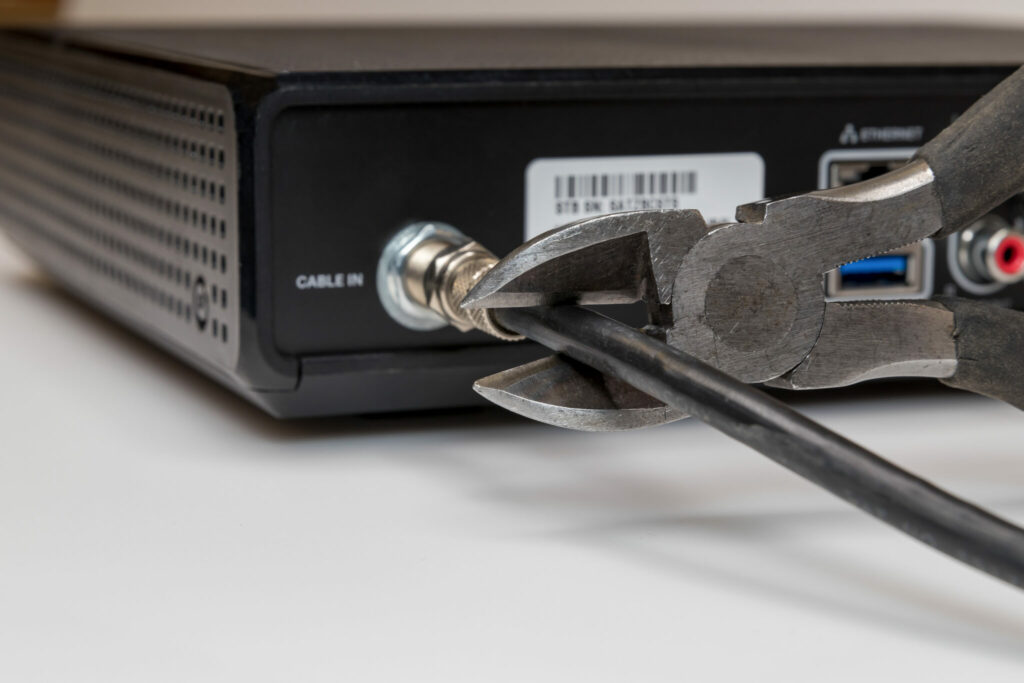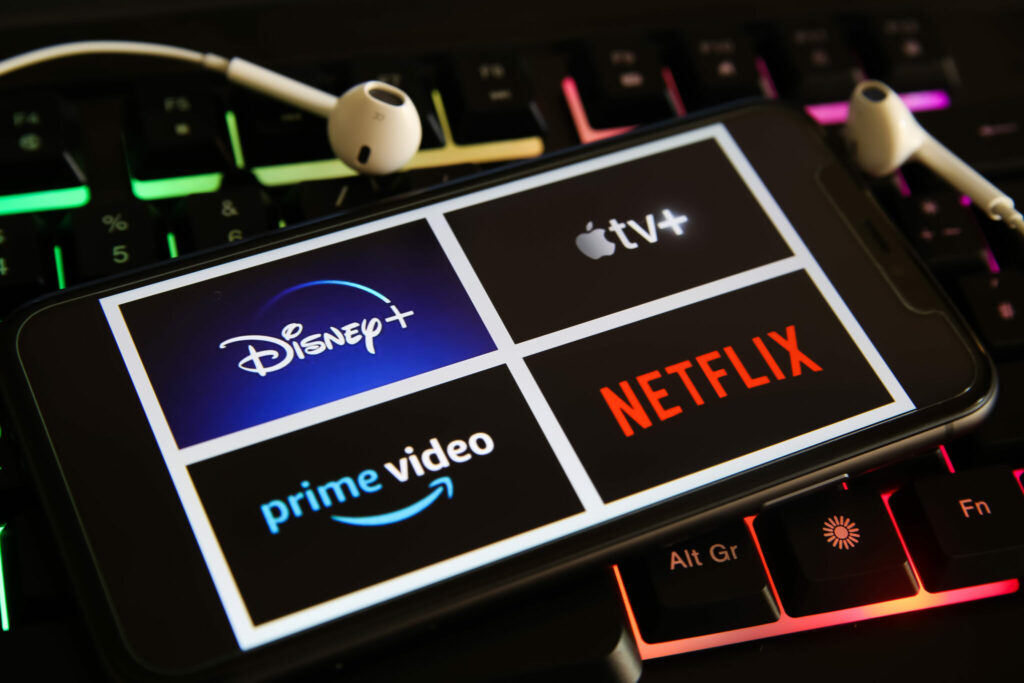Is Cutting the Cord Right for You?

“Cutting the cord” is a euphemism for getting rid of cable or satellite TV service and replacing it with streaming TV services. It’s an appealing option, considering the expense of cable/satellite TV services. With all the available streaming services being offered, why not, right? But, the decision to cut the cord can be more complicated than it seems, making it not the best option for everyone. Aside from the cost-savings argument (more on that in a minute), there are other factors involved: How do you watch TV? Do you like to channel surf and watch live TV and sports, or do you primarily watch movies and original content from Netflix and Hulu? How many household members will be streaming video? Let’s talk about what’s involved with cutting the proverbial cord and whether it makes sense for you.
One note: for this article, we are assuming that our customers want live TV, including news and sports. If you only watch streaming movies and TV shows, then cutting the cable cord makes a lot of sense.
Benefits of Cutting the Cord (and using live streaming services)

- Reduced cost – especially for homes with many TVs
- Reduced cost and simplicity across multiple homes
- Control system integration (special case: RCN)
- Benefits of Cable/ Satellite TV:
- Familiarity
- Reliability
- Most live options, especially for news and sports
- Best voice control (Comcast Xfinity, DishTV)
The Case for Cutting the Cord
The biggest argument for cord-cutting is cost savings – the price of cable/satellite TV service is high and increasing annually. Not only are you paying for the service, but you typically pay a monthly rental fee for each cable box, such as $10 per month for each Xfinity cable box. There are many individual apps that you can get to stream some live and local sports content, but this is a patchwork solution at best. In our experience, the most popular live TV streaming services that are suitable replacements for cable and satellite TV are:
- Hulu + Live TV. This is $69.99 per month for two screens (two individuals can stream content at the same time) and can be upgraded to unlimited screens for an additional $10 per month.
- YouTube TV. $72.99 per month for up to six screens. If you’re a sports enthusiast, YouTube TV is a popular choice for watching regional sports networks.
- NFL Football Fans Take Note: One very interesting note about YouTube TV is that in 2023, they will take over NFL Sunday Ticket, which allows access to all out-of-market football games. DirecTV has had this contract for the last 30 years, so this is a major change. YouTube TV has a presale of NFL Sunday Ticket until June 6, where customers can purchase the package at a $100 discount (for YouTube TV subscribers, $249 or $289, compared to $349 or $389). If you are not a YouTube TV subscriber, these prices are $100 higher still.
Without a cable box, you will need some way to access streaming sources. While there are many options for streaming, including some built into newer TVs, we’re big fans of using the same streaming devices at every TV for a consistent user experience. For this, we love Roku’s lineup of products, especially their 4K-compatible Roku Ultra ($99). The Roku platform is reliable, intuitive, features nearly every streaming service, and integrates well with the systems that Mills offers – including voice control. AppleTV 4K (the physical device, not the streaming service of the same name) is also a good option for die-hard Apple fans. Using the above Roku ultra as an example, during the first year you will break even on purchasing this device compared to “renting” a box from the cable company. After this, the purchased streaming box saves cost.
As cord-cutting has become increasingly popular, the cost of streaming service subscriptions has been increasing as well. You’ll still need an internet connection, which likely is part of your cable bundle. Typically, internet-only packages are priced more expensively than bundled cable TV + Internet packages. The broadband Internet service is often nearly half of what you’re paying for your cable package. You may also need to pay for more bandwidth or upgrade your internet connection to stream HD content. And streaming works best if there is a hardwired Internet connection at each TV. If not, you’ll need to make sure that you have a robust WiFi system capable of multiple concurrent streaming devices.
For those customers with multiple homes (in the US), streaming services can offer a consistent user experience between homes. Rather than, say, Xfinity in a Chicago-area home and Spectrum in a Wisconsin-area home, you can use a service like YouTube TV in both for the same interface. This also can create cost savings if you use a single account. Just be advised there are restrictions: you can only watch from one residence at a time, and while in that residence, you can only watch local channels (which are tied to your IP address).
One last very special use case for streaming involves RCN cable boxes. In Chicago, the cable provider RCN has introduced a new cable box that has its own remote control and cannot be controlled by any “universal” type remotes or home control systems – whether that be Crestron, Control4, URC, etc. We have advised our clients not to upgrade to these boxes, as it may create compatibility issues with our systems. One way around this is to utilize a live streaming service and a physical streaming box like Roku or AppleTV.
The bottom line, there can be cost savings and a consistent user experience achieved by using live TV streaming services. Especially with the change of NFL Sunday Ticket from DirecTV to YouTube TV, there will be increasing interest in streaming.
The Case for Cable/Satellite TV
“If it ain’t broke, don’t fix it.” Many of us have become accustomed to our cable and satellite TV interfaces. And as much as we may complain about the service provided by some of these companies, the actual product is generally pretty good. In particular, we are fans of both the Comcast Xfinity X1 platform and Dish Network’s platform, which do a great job combining live TV with streaming services (Netflix, Amazon, Disney+, etc). They also provide voice control, which should soon be available through our home control systems.
Cable TV (and to a slightly lesser extent satellite TV) provides consistent, reliable signals to your TV – so, generally, you can turn on your TV and expect to get a good picture. Streaming services are not always like that. With streaming, the quality of video depends on available bandwidth, which can vary with the number of users – both inside your home and in your neighborhood who are on the same connection you’re using. So you might get a great picture late in the evening, but right after dinner when more people are watching, picture quality may suffer a bit. Companies such as Netflix will dynamically adjust the quality of the video based on the speed of your connection, and they may downgrade the quality of the video to avoid it freezing or pixelating. Streaming services and network servers can get overwhelmed when a lot of people are trying to watch at the same time, causing crashes and outages. Netflix and Hulu had temporary outages in the spring of 2020 when we were all staying home due to the pandemic. Roku users experienced issues with the CBS All Access and CBS Sports apps during the Superbowl a couple of years ago.
The “Hybrid” Approach
One other option is a “hybrid” approach of the above. Perhaps you have 6 TVs in your home, each with a different purpose. You may find that you want a dedicated cable box for live TV – especially sports and news – in the Family Room, Media Room, and Primary Bedroom. But in the Exercise Room, Playroom, and Guest Bedroom, live TV is almost never watched. One option to save the rental fees on the latter three rooms is to install just a streaming player in those rooms (i.e. Roku). Cable and satellite companies often have a streaming option for their platform that is included with a subscription. So, if you have Comcast Xfinity for the primary three TVs, you can stream live TV to the “secondary” TVs using the Xfinity Stream app. While the app isn’t as good as the X1 platform, it is fine for occasional viewing.
Additional Streaming Services
With either cable/satellite TV or live streaming, many of us add on-demand streaming services that provide exclusive content not found as a part of the basic plans noted above. Keep in mind that subscriptions for Netflix, Amazon Video, Apple TV+, Disney+, ESPN+, HBO Max, Paramount+, and more are all in the $5-$15 per month range and can easily contribute to a large monthly bill.
Conclusion
There is no shortage of options for live TV and streaming, and there is a lot to consider in terms of what is right for your household. If you’re considering cutting the cord, we can help you decide whether cord-cutting is a good option for you and help you navigate through the process – contact us!
